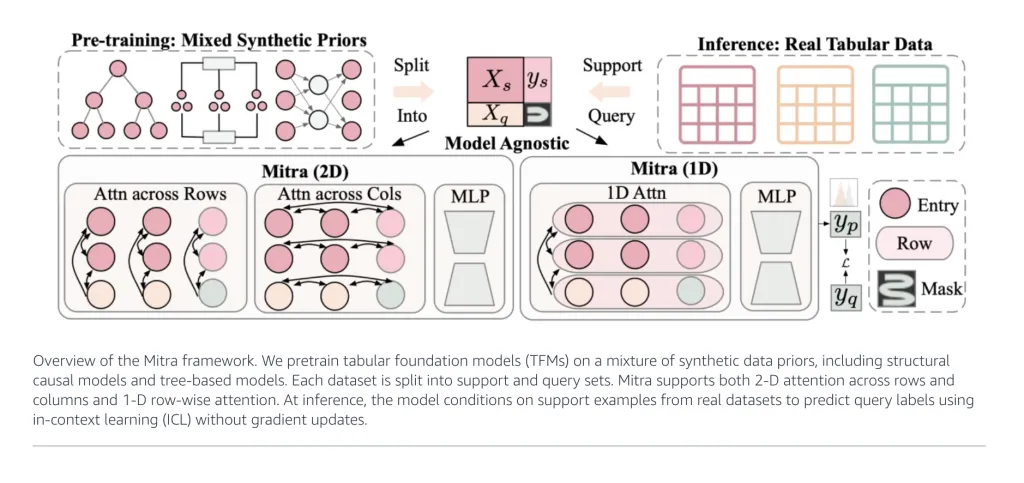Introduction
Amazon researchers have released Mitra, a cutting-edge foundation model purpose-built for tabular data. Unlike traditional approaches that tailor a bespoke model for every dataset, Mitra harnesses the power of in-context learning (ICL) and synthetic data pretraining, achieving state-of-the-art performance across tabular machine learning benchmarks. Integrated into AutoGluon 1.4, Mitra is designed to generalize robustly, offering a transformative shift for practitioners working with structured data in fields like healthcare, finance, e-commerce, and the sciences.

The Foundation: Learning from Synthetic Priors
Mitra departs from the norm by being pretrained exclusively on synthetic data. Rather than relying on the limited and heterogeneous nature of real-world tabular datasets, Amazon researchers engineered a principled strategy for generating and mixing diverse synthetic priors. This approach draws inspiration from the way large language models are pretrained on vast and varied text corpora.
Key Components of Mitra’s Synthetic Pretraining:
- Mixture of Priors: Synthetic datasets are generated from a variety of prior distributions—including structural causal models and tree-based algorithms (like random forests and gradient boosting).
- Generalization: The diversity and quality of these priors ensure that Mitra learns patterns applicable across numerous, unforeseen real-world datasets.
- Task Structure: During pretraining, each synthetic task involves a support set and a query set—enabling Mitra to adapt to new tasks via in-context learning, without requiring parameter updates for every new table.
In-Context Learning and Fine-Tuning: Adapting Without New Models
Traditional tabular ML methods like XGBoost and random forests require a new model for each task or data distribution. In contrast, Mitra leverages in-context learning: given a small number of labeled examples (support set), Mitra can make accurate predictions on new, unseen data (query set) for classification or regression, adapting to each scenario without retraining.
For users who require further adaptation, fine-tuning is also supported, allowing the model to be tailored to specific tasks when needed.
Architecture Innovations
Mitra employs a 2-D attention mechanism across both rows and features, mirroring or extending the architecture advances pioneered by transformers but specialized for tabular data. This enables the model to:
- Handle varying table sizes and feature types.
- Capture complex interactions between table columns and records.
- Support heterogeneous data natively, a key challenge in tabular ML.
Benchmark Performance and Practical Strengths
Results
Mitra achieves state-of-the-art results on multiple major tabular benchmarks:
- TabRepo
- TabZilla
- AutoML Benchmark (AMLB)
- TabArena
Its strengths are especially pronounced on small-to-medium datasets (under 5,000 samples, fewer than 100 features), delivering leading results on both classification and regression problems. Notably, Mitra outperforms strong baselines like TabPFNv2, TabICL, CatBoost, and AutoGluon’s prior iterations.

Usability
- Available in AutoGluon 1.4: Mitra is open-source, with models ready for seamless integration into existing ML pipelines.
- Runs on GPU and CPU: Optimized for versatility in deployment environments.
- Weights shared on Hugging Face: Open-source for both classification and regression use cases.
Implications and Future Directions
By learning from a carefully curated blend of synthetic priors, Mitra brings the generalizability of large foundation models to the tabular domain. It is poised to accelerate research and applied data science by:
- Reducing time-to-solution: No need to craft and tune unique models per task.
- Enabling cross-domain transfer: Lessons learned from synthetic tasks transfer broadly.
- Fostering further innovation: The synthetic prior methodology paves the way for richer, more adaptive tabular foundation models in the future.
Getting Started
- AutoGluon 1.4 will soon feature Mitra for out-of-the-box usage.
- Open-source weights and documentation are provided for both classification and regression tasks.
- Researchers and practitioners are encouraged to experiment and build upon this new foundation for tabular predictio
Check out the Open Weights Classification model, Open Weights Regression model and Blog. All credit for this research goes to the researchers of this project.
Meet the AI Dev Newsletter read by 40k+ Devs and Researchers from NVIDIA, OpenAI, DeepMind, Meta, Microsoft, JP Morgan Chase, Amgen, Aflac, Wells Fargo and 100s more [SUBSCRIBE NOW]
The post Amazon Researchers Reveal Mitra: Advancing Tabular Machine Learning with Synthetic Priors appeared first on MarkTechPost.
Source: Read MoreÂ



